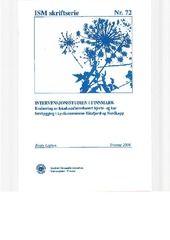| dc.description.abstract | Due to high cardiovascular mortality in Finnmark, Norway’s northernmost county, the aim of
the Finnmark Intervention Study was to improve health and reduce cardiovascular risk factors
in the intervention communities. Those with the poorer health condition should experience the
main improvements. The intervention projects should be based upon empowerment and
participation.<br>
The study bad a quasi-experimental design with community-based intervention in the
communities of Båtsfjord and North Cape, which was independently compared to three
control communities from the same costal area. The intervention started in 1988. It ended in
1991 in BåtsFJord and in 1998 in North Cape. <br>
Data were used from the Finnmark surveys in 1974/75, 1987/88,1990,1993, and 1996.
The effects of the interventions were analysed in the three first papers. Changes in the cohort
which met both in 1987 and 1993, were analysed. The changes in the intervention
communities were compared to the changes in the control communities using analyses of
covariance.
The last paper studies the intervention in a longtime perspective. Cross-sectional analyses
were done on cardiovascular risk factors among 40-42 year olds who took part in the
Finnmark surveys in 1974/75, 1987/88, 1993 and 1996.<br>
Changes in cardiovascular risk factors analysed in paper 1 and 2, gave these main findings:
Compared to the control communities changes in blood pressure were more positive in
Båtsfjord, while changes in BMI and cholesterol were more positive in North Cape. There
was also seen a larger change from boiled coffee to filtered coffee, and larger change from
high-fat to low-fat milk in both intervention communities when compared to control
communities. Finally, the males in Båtsfiord increased their physical activity, and the females
in North Cape reduced their proportion of daily smokers.
Paper 3 found no negative side effects of the Båtsfjord intervention when using information
from questionnaires on seif-rated health and well-being.
The long time perspective of the intervention in paper 4, showed that the Finnmark
Intervention Study started when secular trends in cardiovascular risk factors had been reduced
substantially from 1974 to 1987. After a decline in blood pressure in Båtsfjord during the
intervention period, risk factor levels merged to similar levels in 1996.<br>
The changes we found were a result of a low-cost intervention study with broad involvement
of voluntary organisations, public administration and private enterprise. The study showed it
was possible to use these organisations together with health personnel to promote health and
reduce cardiovascular risk factors in two fishing-villages in Finnmark. | en_US |


 English
English norsk
norsk